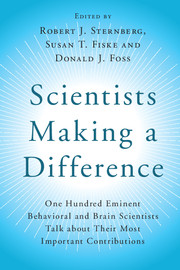 Scientists Making a Difference
Scientists Making a Difference Book contents
- Frontmatter
- Contents
- List of Contributors
- Foreword: Making a Creative Difference = Person × Environment
- Preface
- Part I Introduction
- Part II Biological Bases of Psychology: Genes, Brain, and Beyond
- Section A Feelings, Fears, Stressors, and Coping
- 2 Feelings and Decisions
- 3 My Career in Fear
- 4 Child Poverty and Brain Development
- 5 Try It and Assume Nothing
- 6 Coming Full Circle: From Psychology to Neuroscience and Back
- 7 Hormones, Epigenetics, the Brain, and Behavior
- 8 Brain Plasticity, Science, and Medicine
- Section B Cognitive and Social Neuroscience
- Section C Behavioral and Molecular Genetics
- Part III Cognition: Getting Information from the World and Dealing with It
- Part IV Development: How We Change Over Time
- Part V Motivation and Emotion: How We Feel and What We Do
- Part VI Social and Personality Processes: Who We Are and How We Interact
- Part VII Clinical and Health Psychology: Making Lives Better
- Part VIII Conclusion
- Afterword: Doing Psychology 24×7 and Why It Matters
- Index
- References
3 - My Career in Fear
from Section A - Feelings, Fears, Stressors, and Coping
Published online by Cambridge University Press: 05 August 2016
- Frontmatter
- Contents
- List of Contributors
- Foreword: Making a Creative Difference = Person × Environment
- Preface
- Part I Introduction
- Part II Biological Bases of Psychology: Genes, Brain, and Beyond
- Section A Feelings, Fears, Stressors, and Coping
- 2 Feelings and Decisions
- 3 My Career in Fear
- 4 Child Poverty and Brain Development
- 5 Try It and Assume Nothing
- 6 Coming Full Circle: From Psychology to Neuroscience and Back
- 7 Hormones, Epigenetics, the Brain, and Behavior
- 8 Brain Plasticity, Science, and Medicine
- Section B Cognitive and Social Neuroscience
- Section C Behavioral and Molecular Genetics
- Part III Cognition: Getting Information from the World and Dealing with It
- Part IV Development: How We Change Over Time
- Part V Motivation and Emotion: How We Feel and What We Do
- Part VI Social and Personality Processes: Who We Are and How We Interact
- Part VII Clinical and Health Psychology: Making Lives Better
- Part VIII Conclusion
- Afterword: Doing Psychology 24×7 and Why It Matters
- Index
- References
Summary
As with most important things in life (who your parents were, where you were born, how you met your spouse), my adoption of the acoustic startle reflex as a way to study fear happened by chance. When I entered graduate school in the Yale Psychology Department in 1965, Allan Wagner and others were trying to duplicate studies which reported that rats injected with RNA, extracted from the brain of rats trained to avoid a shock, could actually avoid the shock without being trained themselves. One of these experiments used habituation of the startle reflex. When rats are presented with a loud noise they startle, just like we do when we hear a firecracker or clap of thunder. If the loud noise is presented repeatedly they eventually startle less (habituation of the startle reflex). The study reported that rats injected with RNA from habituated rats did not startle very much – that is, they were already habituated. This did not happen in rats given RNA from non-habituated rats.
My task was to try to reproduce this study. Loving to build things, I made a device to elicit startle by dropping a heavy weight onto an aluminum plate and figured out how to measure startle magnitude in four rats at a time. This system generated reliable “habituation curves” (regular decreases in startle magnitude with repeated presentations of the loud sound), but we saw no transfer of habituation by injecting RNA from habituated rats to naïve rats. However, we all realized this was an efficient and rapid way to collect data on habituation. Allan Wagner and I did several novel habituation studies that were well received by our colleagues, a wonderful reinforcement for a graduate student.
In 1969 I moved to the Yale Psychiatry Department, again by chance. My wife was working there and told me they were investigating the effects of hallucinogens such as LSD on startle habituation in rats. It sounded like a good fit so I interviewed, got a job offer, and spent the next twenty-nine years on the faculty until I moved to Emory University in 1998. Amazing how life goes.
The acoustic startle reflex has an extraordinarily short latency. Electrical activity in the hind leg begins 8 msec after the onset of the auditory stimulus. This is the fastest reflex we have and means it must be mediated by a simple neural pathway.
- Type
- Chapter
- Information
- Scientists Making a DifferenceOne Hundred Eminent Behavioral and Brain Scientists Talk about Their Most Important Contributions, pp. 16 - 19Publisher: Cambridge University PressPrint publication year: 2016
